FAY WRAY
and the Movies
She claimed she was lucky
to be in two great movies
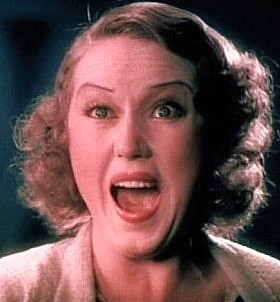
FAY WRAY spent much of her career screaming for help.
I first met legendary "King Kong" star Fay Wray in the checkout counter at Gelson’s Supermarket in Century City in June, 1972.
There I was with my supplies to take back to my hotel room at the Century Plaza hotel (during a TV critics convention) when she tapped me on the shoulder and said, “I just love your coat pin–it’s my Maple Leaf flag, too.”
We sat out in the sunlight for an hour talking old movies and she joined me for lunch the very next day.
We met again in 1974 for High Tea and in 1977 I phoned her about the new version of "King Kong" (the awful one with Jessica Lange in the Fay Wray role), which she positively hated.
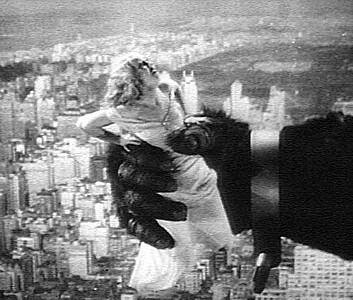
After many telephone chats we met again in 1989 when she roared up in her roadster and took me out to lunch in L.A. She was then promoting her autobiography "On the Other Hand." At 82, she was dazzlingly handsome. No, make that beautifu--poised and chic and filled with stories.
Here are highlights of our talks:
BAWDEN: You are among the most famous of Canadian movie stars. How many of them did you ever meet?
WRAY: I actually did meet Mary Pickford when I was first in L.A, late Twenties. And she was very sweet, gracious. Walter Pidgeon somewhere along the way. These days the Canadian consul general is always inviting me to Canada Day parties at the Canadian offices here. I know Ann Rutherford is Canadian, Yvonne De Carlo, too, Jane Russell lived in Manitoba for years, growing up. But I’ve never been asked to make a movie there. I was eligible to make three movies in England in 1935-36 because I was Canadian, of the Empire.
BAWDEN: Describe your beginnings.
WRAY: I was born near Cardston, Alberta, on a ranch known as Wrayland. Lived there until I was almost four and we had to move to Salt Lake City. The Alberta winters were just too rough for mother. We’d be snowed in for weeks. I know what cabin fever is! My parents emigrated from England at the turn of the century. Dad didn’t really know that much about farming. Mother was too genteel to be a country wife. I had four brothers and sisters. We were miles from the nearest town. I came back for the centenary and the house was gone, only the gigantic rock with Wrayland carved on it had survived and I arranged for it to be transported to L.A. We left in 1911, June, very hot.
BAWDEN: From there you go to L.A.
WRAY: My parents divorced, which was a scandal at the time. And we were very poor, desperately so. As soon as I could I searched for work and decided to apply at the Hal Roach Studios and I got a six months contract just like that! And at $60 a week, heavenly for those days. I got to do a lead in a two reeler with Charley Chase directed by Leo McCarey and I played the ingenue in a Stan Laurel short. I photographed OK, I guess, and I had enough to buy a second hand auto. On my way to work I’d pick up a best buddy, Janet Gaynor, and drive right along Selma Avenue to the Roach studios My family rented a nice, little house based on the money I was bringing in. That was 1925, I’m figuring. Then came two reel westerns at Universal, Janet was there, too. Everything was shot on the Universal backlot and against flats to simulate a western town. My co-stars were Art Accord, Jack Hoxie and Hoot Gibson, who was the biggest star. I learned how to ride. And in 1926 Janet and I were nominated as WAMPAS Baby Stars. It stood for Western Association of Motion Picture Advertisers. Mary Astor was also there at the gala, so were Dolores Costello, Dolores Del Rio and a few others I can't recall offhand. Then Janet said she was quitting westerns to do a film at Fox called "Sunrise," which along with "Seventh Heaven" (and "Street Angel") won her the very first Academy Award. My little buddy became a superstar overnight and I wanted to do the same thing.
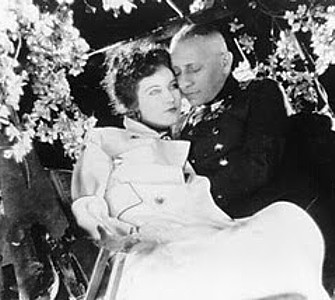
film epic "The Wedding March," with her co-star
and director, Erich von Stroheim.
BAWDEN: How did you get to Paramount?
WRAY: I heard Erich Von Stroheim needed an ingenue for a film he was making at Selig studios called "The Wedding March." But an agent said I was the wrong type–too big and brunette and Von Stroheim wanted a petite blonde. But I persisted and he met with me. And at the end of a long interview he simply stood up and said, “Goodbye, Mitzi.” (Mitzi was the character I’d be playing.) The contract was for $500 a week and I was under contract to Stroheim’s Celebrity Pictures.
There were always musicians on set playing Vienesse music to put us in the mood. Once a scene started, I just got in character and did what I’d been told in rehearsal. There was no dialogue to learn of course. Of course, I fell in love with him a little. It was puppy love, but he never tried to seduce me. I’m not sure what I would have done if he had tried. I was so naive. I watch the film today--thank goodness it has been preserved–and I’m entranced. And it is a great film. The first of two great films I’d ever make.
BAWDEN: How did Paramount get the film?
WRAY: Celebrity Pictures ran out of money and sold the negative to Paramount, along with my contract. And production was halted and that was that. By that time Von Stroheim had shot 200,000 feet of film and made a rough cut of 50,000 feet and was asking to release it in two parts of three hours each! Yes,"Greed" all over again! Joe Von Sternberg took over editing and there were two films after all. "The Wedding March, Part One" ran 14 reels complete with synchronized sound and was a fair commercial hit. Part Two was retitled "The Honeymoon" and ran only in Europe because sound had taken over Hollywood. There was one print of it left at Paris’s Cinemateque and it was destroyed in a vault fire in 1957. Now it is listed as missing. I’ve never seen Part Two.
BAWDEN: You did a few sound films at Paramount. How many?
WRAY: Three. "First Kiss" paired me with Gary Cooper. The studio saw us as the new young lovers but both of us were very restrained. Gary would blush after every smooch. I didn’t care. He was positively beautiful. And "First Kiss" was made so quickly it was released before Paramount got "The Wedding March" down to a commercial length.
Then I made "The Legion of the Condemned." It was written by John Monk Saunders, my first husband. Billy Wellman directed it and it was about flyers in the French Foreign Legion. Again it was love scenes with Coop. But the public couldn’t have cared less. Because before long I was being featured in movies with Dick Arlen. Then I was rushed into "Street of Sin" with Emil Jannings, who spoke atrocious English. The studio was rushing it because everyone sensed his career in America would be destroyed by sound. As it turned out he didn’t even bother to stick around and collect his Oscar (Best Actor, 1927-28, for "The Last Command" and "The Way of All Flesh.") before departing for Germany. Mauritz Stiller directed it –he’d brought over his protege Greta Garbo and she’d run off with John Gilbert and Maury could sense that he, too, was doomed in The New Hollywood.
BAWDEN: I’ve always wanted to see the 1929 version of "The Four Feathers."
WRAY: It had some sound scenes, Merian Cooper, the producer, wanted it all sound but Paramount didn’t have enough equipment. I did Von Sternberg’s first talkie "Thunderbolt." It was made largely all night so the equipment for sound could also be used on another sound film by day. In "Pointed Heels" I was with Bill Powell, a villain in silents, but his great Broadway training was turning him into Paramount’s first talkie star.
Around that time we were all lined up and given talking screen tests. I passed, so did Gary despite his nervousness. Florence Vidor failed and was let go. They let Warner Baxter go around that time and he strolled over to Fox and won an Oscar for "In Old Arizona"! And they lost Richard Dix to RKO and he made "Cimarron," a huge hit. The stars they imported from Broadway were often too old for the cameras. I think only Ruth Chatterton really made it and she was 14 years my senior.
BAWDEN: Then you went to Broadway to star in "Nikki"?
WRAY: I made more Paramount programmers before the studio dropped me in 1931, My husband John Monk Saunders wrote a beautiful play for me and I did it without stage training. I must have been pretty brave! John wrote "Wings" and then "The Dawn Patrol" and then "The Last Flight" with Dick Barthlemess. Helen Chandler played Nikki in that movie but by the time the movie opened I was starring at the Longacre theatre on Broadway in the musical version. I did an audition scene with the tall, dark and handsome leading man and we fell for each other very hard. His name was Archibald Leach. Yes, Cary Grant before he became Cary Grant. The play was pretty terrible, but Archie got the most wonderful reviews. We quickly closed and he was off to Paramount with a new name. He chose Cary from his "Nikki" character’s name, Cary Lockwood.
BAWDEN: You seemed to drift for awhile.
WRAY: It was the height of the Depression. Jobs were scarce. I only was in three 1932 releases. I’d just come off the only stinker Ronnie Colman made back then, a dog awful thing called "The Unholy Garden."
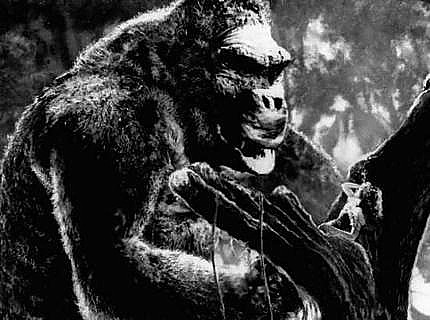
he does battle with a prehistoric monster who wants her, too.
BAWDEN: How did you get to star in the most famous movie in history, "King Kong"?
WRAY: Well, I needed work and Merian Cooper phoned me up and said to come to his offices at RKO. He showed me various sketches of jungle scenes and there was one of a giant ape climbing up the Empire State building. I still hadn’t a clue and when he said, “You’re going to have the tallest, darkest leading man in Hollywood,” I clapped my hands. I thought first of Coop but he wasn’t that dark. Maybe it would be Cary Grant or Gable?. And then he showed me an eighteen inch monkey and introduced us and I felt vastly cheated. Still, I needed work.
Then I listened in rapture as Merian wove his tale–from the primitive jungle to the heights of New York. He said he needed a great actress to put it over. I naively suggested Katharine Hepburn–already at RKO-- and he laughed.
“I said I needed a good actress, not a great personality,” he said.
At a later meeting I got to chat up Edgar Wallace (who wrote the storyline of "Kong"). He was very pudgy and very British. Always eating sweets. Very rotund. Sweated profusely in the Californian warmth. At first, he seemed to think my name was Kay Fay! Which gave us all a laugh. And then 10 days later he caught pneumonia from all that sweating and was soon dead. Merian ditched most of his script and started again with a new one by James Creelman and Ruth Schoedsak.
BAWDEN: When did production begin?
WRAY: Oh, not for months. I was on salary. I’m thinking it was less than $300 a week or so until we started actual production. I actually made about $10,000 from those 10 months of work. Anyhow we first filmed a test reel with back projection in the faux jungle that was being constructed. I was up in a tree screaming and there was a battle between prehistoric monsters. Took 22 hours to film that few minutes but the money men in New York had to have something to raise the money. In fact "KIng Kong" took 10 months, but I had weeks and weeks off between set ups and lay offs, so I made four other films that year. All were in the horror genre. I’d become Hollywood’s scream queen without realizing it.
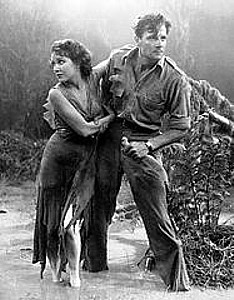
in "The Most Dnagerous Game,"
filmed on the same jungle set
where "King Kong" was filmed.
McCrea was supposed to be her
"Kong" co-star, but was
replaced by Bruce Cabot.
BAWDEN: You did "The Most Dangerous Game" in the "Kong" jungle, but why with Joel McCrea.
WRAY: Because he’d also been signed for "king Kong." But after we filmed "Game," which took two weeks, Joel got upset he was waiting around and not being paid much. So he left in a huff to be replaced by Bruce Cabot. Bruce wasn’t as good an actor and he was a lush so he never had that sustained career. And I later heard from Joel he felt it was the worst career mistake of his life.
BAWDEN: What do you remember about those fantastic scenes in the jungle. How much of "Kong" was full size?
WRAY: Only the mechanical arm that could clench me. I’d be placed in the hand and then the hand would be raised way off the floor. A wind machine gave me that touseled look. And I was scared I’d be thrown and hit that concrete so that screaming is for real. I’d scream for eight hours up there and then I’d almost faint and they’d have to call it a day. Merian (directed) all those technical scenes and Schoedsack did all the scenes on the boat and the landing on the sandy beach and my imprisonment by natives on Skull Island.
BAWDEN: Describe the premiere.
WRAY: There were two of them. It first opened at Radio City Music Hall and played to packed houses for weeks. There was a lineup for the 9:45 a.m. screening! Then two weeks later it opened again, this time in L.A. at Sid Graumann’s Chinese. Wonderful reviews for the film but not much said about the human actors, for good reason. I simply thought I screamed too much. I spent a week recording screams to be interpolated through the film. But to be in such a hit was a huge plus, I guess. It literally saved RKO from bankruptcy and did so several more times over the next 15 years. I heard the take up to 1950 was something like $7 million. And then in the late Forties, when I wasn’t acting anymore and was sprinting over Olympic boulevard, a very nice young chap stopped me and shouted ,“Beauty! Where’s your Beast?” Or something like that and I felt I’d become part of history.
BAWDEN: Do you still watch it on TV?
WRAY: I really would watch more often if I had residuals. It cost $680,000, a huge sum in those days. Made several millions the first issue and about the same when reissued every seven years or so. Somebody got very rich off it. Not me. Not Ernest Schoedsack, who had it all figured out how much RKO owned us. But there’s no RKO any more is there?
BAWDEN: That same year you also made "Doctor X" and "Mystery of The Wax Museum" at Warners, both starring Lionel Atwill and both directed by Michael Curtiz.
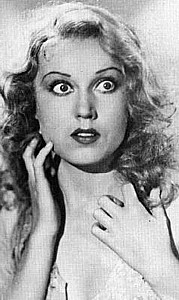 |
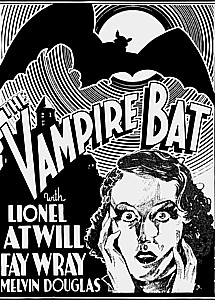 |
| Fay Wray became Hollywood's "scream queen" in 1932-33 when she made four horror films in a row--"Doctor X," "Mystery of the Wax Museum," "The Vampire Bat" and "KIng Kong." | |
WRAY: That’s right. Both were in early two-tone Technicolor. The movie cameras were immense but the arc lights were so intense I’d get spots in my eyes. And the heat generated was something else. Lionel was a very handsome older man who’d been acting since he was a little boy. But there was a depth of depravity there. Stories of orgies at his home intrigued us all. He was married to the ex-wife of General Douglas MacArthur and to be invited to one of their so-called parties was considered a great moment. But I demurred. And later when details were leaked out Lionel was virtually blacklisted by the film community.
The sets in "Wax Museum" are very Germanic. I think it’s better than "Dr. X," which is far more gruesome. In "Museum," Glenda Farrell and Stu Erwin are so funny with their fast talking repartee. But we shot some scenes from the two movies one after the other. I just had to scream, so who cares what movie I was in at that time? Curti, you know, was the nastiest of directors, concerned with lighting and shadows, ignored me most of the time. But once he lit into Glenda and she shouted right back at him and the crew applauded.
Then because I had 10 days off I did "The Vampire Bat" with Lionel and Melvyn Douglas. I mean, Mel had just acted with Garbo. Now this? Dwight Frye from "Dracula" was in it, too, and a fellow Canadian, Maude Eburne.It was the Depression and nobody could afford to turn down work. But it’s the only time I worked with Mel. Who knew two Oscars were in his future–30 years in the future.
BAWDEN: You also acted that year with Spencer Tracy in "Shanghai Madness"?
WRAY: A strange man. Undoubtedly a great actor. But so wracked by personal problems. My apartment in Century City looks down upon the old Fox lake, which is now paved over with condominiums. And when I look down I think of Spence. He came on to me. He came on to every girl. And when he drank, look out. He went on a bender on this one that lasted for days. His wife was distraught, so I went out on a tour of Hollywood’s seedy bars and I found him. Fox dried him out but a few years later he was dropped because of his alcoholism. I was up for the co-lead in "A Man’s Castle," but (director) Frank Borazge chose Loretta Young and she really fell for Spence. I saw right through him, which could be the reason Spence asked that I not be chosen. When Fox fired him for alcoholism in 1935 he cried in his dressing room but moved over to MGM and became a big star. Met him decades later and he just nodded and walked on. Was he embarrassed I might have remembered his drunken antics? Or did he simply not remember?
BAWDEN: Another movie you squeezed in in 1933 was "The Bowery."
WRAY: The first movie made by Twentieth Century. Louis Mayer put up half the funds for that company and loaned two of his biggest stars, Wally Beery and Jackie Cooper, fresh from "The Champ." It wasn’t much and George Raft was such a gentle man he blanched in one scene where he has to sock me. He barely touched my cheek. Director Raoul Walsh yelled, “Slug that b-tch” and George did it again just as daintily. And twelve more taps until I said, “Do it and let’s move on”. All those taps and I had a bigger welt than if he’d really slugged me once really hard.
Darryl Zanuck ordered me into his office and said if I’d just play along I could be a big star. He said I could star next with Clark Gable in "Call of the Wild" and after that with George Arliss in "Cardinal Richelieu." A contract at Twentieth Century would have saved me from slavery in B pictures. I was rapidly descending because I lacked a long term major studio contract. Then he tried to kiss me and I ran out sobbing. If I’d played along who knows how far I would have gone?
BAWDEN: You made your last picture with Cooper in 1933, "One Sunday Afternoon"?
WRAY: Never seen these days on TV because Paramount sold remake rights to Warners which redid it as "The Strawberry Blonde" with Jimmy Cagney. I had the “bad girl” part, that of Virgie Barnstead. It was so strange. I’d been gone, what, two years and everybody had changed. (Pasramount Chief Jesse) Lasky was out in a coup engineered by Adolph Zukor. Almost all the other stars of my era with the exception of Coop were gone. He was still Gary, never really bothering to memorize his line, cat napping between scenes, still blushing during kissing scenes. He was attached to a lovely girl, Rocky, who can actually be seen screaming in the New York sequence of "Kong." She was good for him and he was beginning to grow into the Coop myth. Hey, it worked a long time for him didn’t it?
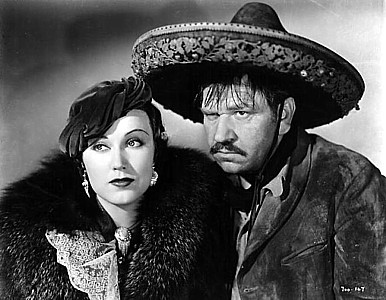
one of the "A" pictures she made at MGM.
BAWDEN: But you were in another big picture, MGM’s "Viva Villa "(1934).
WRAY: It had been filming in Mexico, Howard Hawks directing. And one of the stars, that delicious alcoholic Lee Tracy, stood on a balcony stark naked in front of the assembled Mexican army and tinkled on them. Well, it provoked an international incident. The entire company got deported. Hawks was fired to be replaced by Jack Conway. Mona Barry was the girl and she was changed, too –for me. Stu Erwin replaced Tracy and only Wallace Beery was left and great gobs of the story had to be re-filmed. You see I looked Latin and I resembled Mona, who can still be glimpsed in some very long shots. David Selznick liked me after "Kong" (which he executive produced) and later had me make a test for "The Prisoner of Zenda," but Mary Astor got that part. By that time I was hopelessly mired in the Valley of the Bs.
BAWDEN: Besides Villa you made nine other movies in 1934.
WRAY: I was busy, yes, but stardom had once again eluded me. "The Affairs of Cellini" wrapped up my TC short contract. It was artistically fine but a bit of a bomb box office wise, even with Connie Bennett, Frank Morgan and Freddie March in the cast. The only other "A" film was "The Richest Girl in the World" at RKO with Miriam Hopkins in the lead. I had the second lead and it was OK, I guess. I did a lot of Bs around then with Ralph Bellamy and we’re still friends.
BAWDEN: Why did you move to Britain in 1935 for pictures?
WRAY: To escape a faltering marriage. So I get off the boat, a BBC reporter is there and we are to go to BBC headquarters for an interview. And all they want me to do is scream into the microphone. Which I do and it promptly breaks the service. And BBC is off the air for minutes until repairs can be made.
I signed with Gaumont British and a lot of Yank stars were over there at that time: Bob Young, Connie Bennett, Eddie Robinson. First up I made "Bulldog Jack" starring Jack Hulbert and a young man named Ralph Richardson. I remember waiting around for weeks with nothing to do but see the sights. The film was funny if you liked Jack Hulbert, but he was unknown in the U.S. and it had few play dates.
Then it was on to "The Clairvoyant" opposite the greatest actor I ever met–Claude Rains. A very tiny man . But Claude was only just starting out in movies and it played the bottom half of double bills. Then I stayed to co-star with Jack Buchanan in "Come Out of the Pantry." Another credit few have ever seen over here. But I needed money, so I signed for another Jack Buchanan starrer, "When Knights Were Bold." This one was rather good. I hear from my Canadian cousins it was a hit in your dominion. But not in the U.S. There was a sticky moment when it turned out I wasn’t eligible as an American to work so long in the U.K. When the British chap heard my story about being born in Canada he gave me a British passport. Which I still cherish although I only used it that one time. As you know Canadian passports did not exist then. We Canadians were all citizens of the British Empire. And when I returned to Hollywood I’d been away so long I was forgotten.
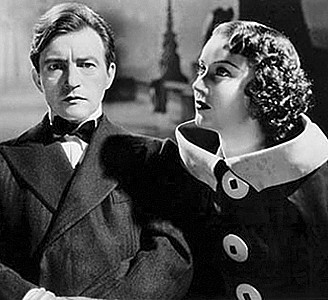
filmed during her days working in England.
BAWDEN: You went back to L.A and to Columbia?
WRAY: Needed work, any work. The marriage floundered, I had a baby daughter. Columbia was the home of "B" pictures and I was a former silent actress, now 30, and hardly a new face. Harry Cohn knew a good deal and offered me a five-year non exclusive thing. I’d first met him on loan out to do "Dirigible" in 1931. I warned him I was pregnant. Harry was very solicitous, said he’d always wanted a son. But he paid just enough to meet the bills. Columbia made its Bs in two weeks –12 days. And one worked every minute.
My first was "Roaming Lady" with Ralph Bellamy. Then I made "They Met In A Taxi" with Ralph. Alfred E. Green directed it, he being a refugee from Warners. In "It Happened in Hollywood" I had the great Richard Dix as partner and in "Murder In Greenwich Village" it was another Paramount refugee, Dick Arlen. We hadn’t worked together since "Border Legion" in 1930 and seven years later we were industry retreads.
BAWDEN: Your career was winding down?
WRAY: You said it! Only one movie in 1938–and a bad programmer at Universal titled "The Jury’s Secret." In 1939 I did "Navy Secrets" at Monogram and "Smashing the Spy Ring" at Columbia, again with Ralph. We were the King and Queen of the B’s by then. I desperately wanted to play Belle Watling in "Gone With the Wind" but Selznick said I was too young. I don’t think I even got to test on that one. I had to settle for "Wildcat Bus" (1940) at RKO. You’ve never seen it? Lucky you!
BAWDEN: You had one last big picture.
WRAY: Yes, "Adam Had Four Sons" at Columbia. I was plainly on my last legs and newcomer Susie Hayward was all the talk. Although Warner Baxter was the nominal star, a new Selznick contractee, Ingrid Bergman, got all the attention. I played his first wife and disappeared fairly early. One day Warner whispers in my ear just before a scene: “To think it has come to this!” I knew exactly what he was talking about.
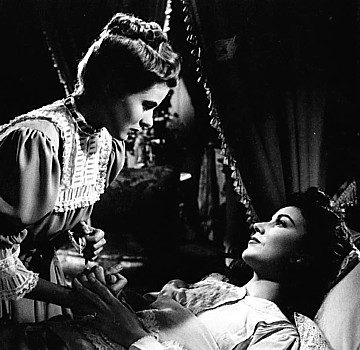
in "Adam Had Four Sons."
Flash forward a quarter of a century and a little more to an island in the Gulf of St. Lawrence beside Montreal. It’s Expo ’67 and I’m there showing "King Kong" to an overflow crowd. Who should pop out of the audience but my "Adam Had Four Sons" co-star Ingrid Bergman. And then along comes Gloria Swanson, who takes me aside and mutters, “Isn’t it said how badly Ingrid has aged?”
BAWDEN: You only made two more B’s and then retired at the grand old age of 35?
WRAY: The still from "Not A Ladies Man"–Columbia, 1942--See, here’s the still you just gave me. I can't remember anything about it except the boy, Douglas Croft.
BAWDEN: You co-wrote a play with Sinclair Lewis around that time.
WRAY: I was always getting involved with writers. I went to Cohasset, Massachusetts, to do summer stock, a play called "George and Margaret." And it was there I met Sinclair Lewis. He’d been at a dinner party once in L.A. as I recall. He was getting ready to act in a play he’d written, "It Can’t Happen Here." Then he followed me on to my next stop. I mean he was the ugliest man I’d ever met–pockmarks, teeth stained from tobacco. He started writing a play for the two of us called "Angela is Twenty-Two" And it was strange by then there was also Howard Hughes in pursuit. All this did wonders for my morale. Maybe I wasn’t so old after all.
BAWDEN: Your second husband was also a screen writer.
WRAY: That’s right Bob Riskin. Got the Oscar for "It Happened One Night." That picture made him and it made Frank Capra, who is very cruel in his memoirs to Bob. Frank wanted all the glory, but he couldn’t write two sentences down and have them make sense. I met Bob in 1941 at a party hosted by Richard and Jessica Barthlemess. And we married and had two lovely children. Who wanted to act? Time to be a stay-home mom.
And then one day in 1951 Bob came home from Fox, where he’d been writing a script for Clifton Webb as "Mr. Belvedere." Said he was weak in one arm. Been having blinding headaches for weeks but didn’t want to tell me. Within days he was operated on but he never quite recovered. He was paralyzed. And there was no money coming in.
BAWDEN: Is that why you returned to work?
WRAY: Oh, yes. I phoned Darryl Zanuck, who was Bob’s boss. And he arranged to give me a small, but choice part in "The Treasure of the Golden Condor" (1952). I’d been away from acting for just a decade, you see.. then MGM phoned. Would I mind playing Jane Powell’s mom in "Small Town Girl" (1953). Would I? She was sweet and very professional and we had a ball. And then all that summer I did a TV situation comedy for CBS called "Pride of the Family," a kind of poor man’s "Father Knows Best." My 16-year-old daughter was played by Natalie Wood, desperate at that time for work. Two years later she was in "Rebel Without A Cause" and had an all new career ahead of her.
BAWDEN: You became the mother to a whole new generation?
WRAY: Oh, yes. There was little Debbie Reynolds, although I was actually the mother of the bachelor, Leslie Nielsen. And John Saxon in "Rock Pretty Baby" and Gary Clarke in "Dragstrip Riot" (1957) and John Saxon again in "Summer Love" (1958). I was busy!
BAWDEN: You also had choice parts in a few big “A” productions.
WRAY: Well, "The Cobweb" was just plain weird, but I got to know and admire Miss Lillian Gish. Then there was "Queen Bee" –a Joan Crawford soap. She wrote me a welcoming note saying how she’d always admired veterans of the silent days. And I never had the courage to inform her I was actually a year younger than she was. On every Crawford picture, she had a younger cast member to berate and on this one when she had to slap pretty little Lucy Marlowe she did so with such fury it could be heard all over the sound stage.
With Barbara Stanwyck ("Crime of Passion") ,here was a true pro, in her last year of screen stardom. We shot mostly on locations just to save money. One day I saw her applying her own makeup beside the truck before a shoot. She looked up and just shrugged. Who could blame her. This production was cost efficient.
BAWDEN: After 1954 you did a ton of TV work.
WRAY: Paid the bills and some of it was fun. "Alfred Hitchcock Show" always treated actors well. I was on a few of those. I did three "Perry Masons"--nice money, good working conditions, two for "Jane Wyman," "Wagon Train," "G.E. Theater" on multiple occasions. But I stopped acting after the Kennedy assassinations. Just lost all hope for a long spell. Only acted once since then: in "Gideon’s Trumpet" in 1980, playing Hank Fonda’s landlady. A very introverted, circumspect man, the compleat actor, very much at the top of his game despite physical infirmities. I did that for my daughter Susan Morgan, who produced it. But there were no more offers after that. And. Yes, you are right I did decline THAT role in "Titanic," but I thought it would be too much for me and I’d disappoint too many people (Gloria Stuart substituted).
BAWDEN: You remarried in 1970.
WRAY: To Dr. Sandy Rothenberg who operated on Bob in 1951. We were both free 20 years later and we live across the street from the Century City hospital where he works. He insists we dine out every night, which means I don’t have to cook. And we never tire of finding new restaurants. Occasionally I’ll go out with a showing of "King Kong" or better yet "The Wedding March." My two great films! I’m so lucky! Many of my contemporaries never had one great movie. And I’ve got two to my name.
Dr. Sanford Rothenberg died on Jan. 18, 1991.Fay Wray died of natural causes on Aug. 8, 2004, in New York City, a month and a few days short of her 97th birthday. On Aug. 10, the lights on the Empire State building were dimmed for 15 minutes in her memory, which was completely appropriate. She is buried at Hollywood Forever cemetery right behind Paramount studios, where she became a star. In 2006 Canada Post honored her with her picture on a 51 cent commemorative stamp as one of four Canadians who made it in Hollywood. The others: Mary Pickford, Lorne Greene and John Candy . |
